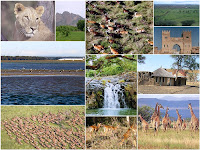Madagascar
 Off Africa's southeast coast in the Indian Ocean, Madagascar is the world's fourth largest island after Greenland, New Guinea, and Borneo. A stunning diversity of plant and animal species found nowhere else evolved after the island broke away from the African continent 165 million years ago. It has a mountainous central plateau and coastal plains. The first settlers were of African and Asian origin, and 18 separate ethnic groups emerged, derived from an African and Malayo-Indonesian mixture. Asian features are most predominant in the central highlands people, and coastal people tend to show features of African origin. Most of the population depend on subsistence farming, based on rice and cattle, with coffee, vanilla, and seafood being important exports.
Off Africa's southeast coast in the Indian Ocean, Madagascar is the world's fourth largest island after Greenland, New Guinea, and Borneo. A stunning diversity of plant and animal species found nowhere else evolved after the island broke away from the African continent 165 million years ago. It has a mountainous central plateau and coastal plains. The first settlers were of African and Asian origin, and 18 separate ethnic groups emerged, derived from an African and Malayo-Indonesian mixture. Asian features are most predominant in the central highlands people, and coastal people tend to show features of African origin. Most of the population depend on subsistence farming, based on rice and cattle, with coffee, vanilla, and seafood being important exports.French colonial rule began in 1896; independence came in 1960. In 1990, after almost 20 years of Marxism, Madagascar lifted a ban on opposition parties, and a new president was elected in 1993. Elections in 2001 resulted in a period of civil unrest, lasting for several months, until Marc Ravalomanana was declared winner of the presidential election. Environmental degradation is a major concern as damaging agricultural practices cause deforestation, soil erosion, and desertification. The island is heavily exposed to tropical cyclones, which brought destructive floods in 2004. National Geographic
More on Madagascar: WWF, Wild Madagascar, Islands, Africa Guide, Infoplease, Lonely Planet, Worldtravelguide, Madagascar Travel, Air Mad, PBS.org, Wikipedia, Greatest Places, Enchanted Learning, Visit Madagascar, BBC, Picasa
Image: Google Image


